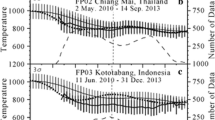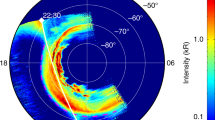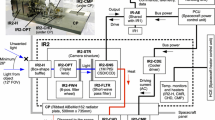Abstract
Efforts are made to demonstrate high-resolution observations of the solar atmosphere using spatial interferometry. Covering the telescope pupil with a Fizeau mask consisting of two small circular apertures separated by a vector distance known as the baseline is the first step towards interferometric imaging. A mask with two circular holes of diameter 7 cm each and separated by a distance of 19 cm is placed in the pupil plane of the Multi-application solar telescope at Udaipur solar observatory. The fringe pattern observed in the image plane signifies the presence of solar structures with sizes smaller than the fringe period. The study is extended with baselines of 29 cm and 38 cm. It is observed that an increase in the baseline causes a reduction in the fringe period and the fringe contrast. Observations are carried out in two spectral lines/bands, centered at 656.3 nm and 861.0 nm using filters of bandwidth 1 nm and 330 nm, respectively. The effect of bandwidth on the fringe visibility is also discussed based on the bandwidth decorrelation function.





Similar content being viewed by others
References
Baldwin, J.E., Haniff, C.A., Mackay, C.D., Warner, P.J.: 1986, Closure phase in high-resolution optical imaging. Nature320(6063), 595. DOI . ADS .
Baldwin, J.E., Beckett, M.G., Boysen, R.C., Burns, D., Buscher, D.F., Cox, G.C., Haniff, C.A., Mackay, C.D., Nightingale, N.S., Rogers, J., Scheuer, P.A.G., Scott, T.R., Tuthill, P.G., Warner, P.J., Wilson, D.M.A., Wilson, R.W.: 1996, The first images from an optical aperture synthesis array: Mapping of Capella with COAST at two epochs. Astron. Astrophys.306, L13. ADS .
Born, M., Wolf, E.: 1975, Principles of Optics. Electromagnetic Theory of Propagation, Interference and Diffraction of Light. ADS .
Damé, L.: 1998, Low orbit high resolution solar physics with the solar interferometer. Adv. Space Res.21(1–2), 295. DOI . ADS .
Damé, L., Derrien, M.: 2002, Solar physics and interferometry mission (SPI). Adv. Space Res.29(12), 2061. DOI . ADS .
Damé, L., Derrien, M., Kozlowski, M., Merdjane, M.: 1998, Laboratory and sky demonstrations of solar interferometry possibilities. In: Crossroads for European Solar and Heliospheric Physics. Recent Achievements and Future Mission Possibilities, ESA Special Publication417, 345. ADS .
Fried, D.L.: 1966, Optical resolution through a randomly inhomogeneous medium for very long and very short exposures. J. Opt. Soc. Am.56(10), 1372. DOI . ADS .
Golay, M.J.E.: 1971, Point arrays having compact, nonredundant autocorrelations. J. Opt. Soc. Am.61(2), 272. DOI .
Hanbury Brown, R.: 1956, A test of a new type of stellar interferometer on Sirius. Nature178(4541), 1046. DOI . ADS .
Haniff, C.: 2007, An introduction to the theory of interferometry. New Astron. Rev.51(8–9), 565. DOI . ADS .
Haniff, C.A., Mackay, C.D., Titterington, D.J., Sivia, D., Baldwin, J.E.: 1987, The first images from optical aperture synthesis. Nature328(6132), 694. DOI . ADS .
Harvey, J.W.: 1972, Interferometry applied to visible solar features. Nat. Phys. Sci.235(57), 90. DOI . ADS .
Korff, D.: 1973, Analysis of a method for obtaining near-diffraction-limited information in the presence of atmospheric turbulence. J. Opt. Soc. Am.63(8), 971. DOI . ADS .
Kumar, B., Venkatakrishnan, P., Bayanna, A.R., Venugopalan, K.: 2007, Site characterization using solar H\(\alpha\) images. Solar Phys.241(2), 427. DOI . ADS .
Labeyrie, A.: 1975, Interference fringes obtained on Vega with two optical telescopes. Astrophys. J. Lett.196, L71. DOI . ADS .
Lawson, P.R.: 2000, Principles of Long Baseline Stellar Interferometry. ADS .
Lohmann, A.W., Weigelt, G., Wirnitzer, B.: 1983, Speckle masking in astronomy: Triple correlation theory and applications. Appl. Opt.22(24), 4028. DOI . ADS .
Mathew, S.K.: 2009, In: Berdyugina, S.V., Nagendra, K.N., Ramelli, R. (eds.) A New 0.5m Telescope (MAST) for Solar Imaging and Polarimetry, Astronomical Society of the Pacific Conference Series405, 461. ADS .
Mathew, S.K., Bayanna, A.R., Tiwary, A.R., Bireddy, R., Venkatakrishnan, P.: 2017, First observations from the Multi-Application Solar Telescope (MAST) narrow-band imager. Solar Phys.292(8), 106. DOI . ADS .
Michelson, A.A.: 1920, On the application of interference methods to astronomical measurements. Astrophys. J.51, 257. DOI . ADS .
Michelson, A.A., Pease, F.G.: 1921, Measurement of the diameter of \(\alpha\) Orionis with the interferometer. Astrophys. J.53, 249. DOI . ADS .
Miller, N.J., Dierking, M.P., Duncan, B.D.: 2007, Optical sparse aperture imaging. Appl. Opt.46(23), 5933. DOI . ADS .
Monnier, J.D.: 2003, Optical interferometry in astronomy. Rep. Prog. Phys.66(5), 789. DOI . ADS .
Mourard, D., Bosc, I., Labeyrie, A., Koechlin, L., Saha, S.: 1989, The rotating envelope of the hot star gamma Cassiopeiae resolved by optical interferometry. Nature342(6249), 520. DOI . ADS .
Roddier, F.: 1986, Triple correlation as a phase closure technique. Opt. Commun.60(3), 145. DOI . ADS .
Saha, S.K., Venkatakrishnan, P., Jayarajan, A.P., Jayavel, N.: 1987, Astrophotography with high angular and temporal resolution: Preliminary results from the Kavulur experiments. Curr. Sci.56(19), 985.
Sridharan, R.: 2001, Techniques for achieving higher spatial resolution. PhD thesis, Bangalore University, Bangalore, India. http://hdl.handle.net/10603/89167 .
Tiwary, A.R., Mathew, S.K., Bayanna, A.R., Venkatakrishnan, P., Yadav, R.: 2017, Imaging spectropolarimeter for the multi-application solar telescope at udaipur solar observatory: Characterization of polarimeter and preliminary observations. Solar Phys.292(4), 49. DOI . ADS .
Tuthill, P.G., Monnier, J.D., Danchi, W.C.: 1999, A dusty pinwheel nebula around the massive star WR104. Nature398(6727), 487. DOI . ADS .
Tuthill, P.G., Monnier, J.D., Danchi, W.C., Lopez, B.: 2000a, Smoke signals from IRC +10216. I. Milliarcsecond proper motions of the dust. Astrophys. J.543(1), 284. DOI . ADS .
Tuthill, P.G., Monnier, J.D., Danchi, W.C., Wishnow, E.H., Haniff, C.A.: 2000b, Michelson interferometry with the Keck I telescope. Publ. Astron. Soc. Pac.112(770), 555. DOI . ADS .
Venkatakrishnan, P.: 2001, Multi-aperture solar telescope. Bull. Astron. Soc. India29, 467. ADS .
Venkatakrishnan, P., Mathew, S.K., Srivastava, N., Bayanna, A.R., Kumar, B., Ramya, B., Jain, N., Saradava, M.: 2017, The multi aperture solar telescope. Curr. Sci.113(4), 686.
von der Luehe, O.: 1984, Estimating Fried’s parameter from a time series of an arbitrary resolved object imaged through atmospheric turbulence. J. Opt. Soc. Am. A1, 510. DOI . ADS .
von der Lühe, O.: 1992, In: Sanchez, F., Collados, M., Vazquez, M. (eds.) High Spatial Resolution Techniques, 1. ADS .
von der Lühe, O.: 1993, Imaging of the solar surface with interferometric arrays. In: Radick, R.R. (ed.) Real Time and Post Facto Solar Image Correction, 150. ADS .
Weigelt, G.P.: 1977, Modified astronomical speckle interferometry “speckle masking”. Opt. Commun.21(1), 55. DOI . ADS .
Zirker, J.B.: 1987, Interferometric imaging: A numerical simulation. Solar Phys.111(2), 235. DOI . ADS .
Zirker, J.B.: 1989, Interferometric imaging – Part two. Solar Phys.120(2), 253. DOI . ADS .
Acknowledgements
We thank Ms. Ramya Bireddy and Ms. Anisha Kulhari for their support with MAST telescope operations during the observations. We also thank Mr. Mukesh Sardava for helping with fabrication of Fizeau masks. We also thank the referee for the encouraging comments.
Author information
Authors and Affiliations
Corresponding author
Ethics declarations
Disclosure of Potential Conflicts of Interest
The author declares that there are no conflicts of interest.
Additional information
Publisher’s Note
Springer Nature remains neutral with regard to jurisdictional claims in published maps and institutional affiliations.
Appendix: Bandwidth Decorrelation Function for Filters Used in This Work
Appendix: Bandwidth Decorrelation Function for Filters Used in This Work
In stellar interferometry and imaging, the bandwidth decorrelation function \(G(x)\) is defined as the absolute value of the Fourier transform of the function representing the spectral transmission function \(T(k)\) expressed in wavenumber (\(k= 1/\lambda\)) space. Figure 6 shows the near-infrared spectral transmission function of the spectral filter used for NIR observations. The central or mean wavelength of this filter is estimated using:
where \(F(\lambda)\) and \(T(\lambda)\) are the solar terrestrial spectral irradiance, and the spectral transmission in wavelength space, respectively. The limits of integrations indicate wavelength in nm. From this the mean wavelength is estimated as 860.9 nm. The full width at half maximum of this filter measured based on the definition is \({\approx}\,330\) nm.
Figure 7 shows the bandwidth decorrelation function \(G(x)\), estimated as the absolute value of the discrete Fourier transform of \(T(k)\). We note that the first minimum of the bandwidth decorrelation function is around 2250 nm which is close to the coherence length \(\Lambda= {\lambda}^{2}/\Delta\lambda\) (\(= 861\times861/330 = 2246\) nm). In practice, the squared visibility is multiplied by the square of the bandwidth decorrelation function. The value of the bandwidth decorrelation function could be deduced from the two plots shown in Figure 7. The theoretical value of the rms OPD for a given baseline is given by \(0.417\lambda(L/r_{0})^{5/6}\). This is shown in the left panel of Figure 7. The attenuation corresponding to that OPD is then extracted from the right panel of Figure 7. The estimated squared visibilities is divided by the bandwidth decorrelation function to remove the finite bandwidth effect.
Rights and permissions
About this article
Cite this article
Raja Bayanna, A., Venkatakrishnan, P., Rengaswamy, S. et al. Fizeau Mask Interferometry of Solar Features Using the Multi-application Solar Telescope at the Udaipur Solar Observatory. Sol Phys 295, 30 (2020). https://doi.org/10.1007/s11207-020-1597-1
Received:
Accepted:
Published:
DOI: https://doi.org/10.1007/s11207-020-1597-1






